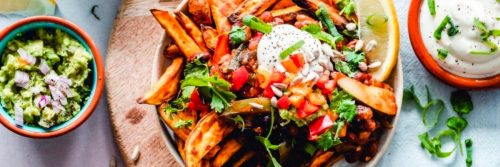The word protein comes from the Greek ‘proteios’ meaning ‘primary’ or ‘first rank’ because proteins are an indispensable nutrient in the human diet. They are a vital component of every cell in the body and have many different roles. Proteins are needed for hormones, neurotransmitters, digestive enzymes, immune function, fluid balance, bone formation, muscle growth, transport of oxygen and minerals, and repair of damaged tissues. During times of growth (eg childhood, adolescence and pregnancy) new cells are forming and our protein requirements increase.
There are more than 10,000 different proteins in the human body. Proteins are made of smaller nitrogen-containing compounds called amino acids. Hence amino acids are referred to as the building blocks of proteins. We require 20 different amino acids to make all the proteins we need. Each protein consists of a subset of these 20 amino acids linked together in a specific sequence. After digestion, dietary proteins are broken down into their constituent amino acids and our body makes its required proteins by recombining the necessary amino acids.
Of the 20 amino acids, 9 of them are referred to as ‘essential’ because we need to eat them on a daily basis or we’ll get sick and die. The other 11 amino acids are called ‘non-essential’ because even though we need them to survive, we can make them without having to eat them.
Dietary proteins are classified into two types. ‘Complete proteins’ contain all 9 essential amino acids. ‘Incomplete proteins’ contain some but not all of the 9 essential amino acids. Animal products such as meat, poultry, fish, eggs and dairy all contain complete proteins. Vegetable proteins such as beans, legumes and nuts are all incomplete proteins and therefore you need to eat more than one type of plant protein every day to obtain your full set of 9 essential amino acids. The exception is soybeans. They are the only plant that is a complete protein. Therefore tofu, tempeh and other soy products are good sources of protein for vegans.
The traditional diets of various cultures show which combinations of vegetables complement each other to give us the 9 essential amino acids: Beans and corn in Mexico, couscous and chickpeas in North Africa, and cracked wheat and parsley in tabbouli are examples of food combinations where the missing amino acid in one food is supplied by the other food. Even the manic pace of life today allows for easy protein combining: beans on toast or a peanut butter sandwich (wholegrain of course) will do the trick.
If you’re vegan, there’s no need to get worked up about whether you’re consuming all 9 essential amino acids every day. You don’t need to eat all 9 in the one meal, you simply need to get them within a 24 hour period. As long as you’re eating a variety of plant proteins, you’ll get there.









Protein nourishes your body and is a must have in your diet.